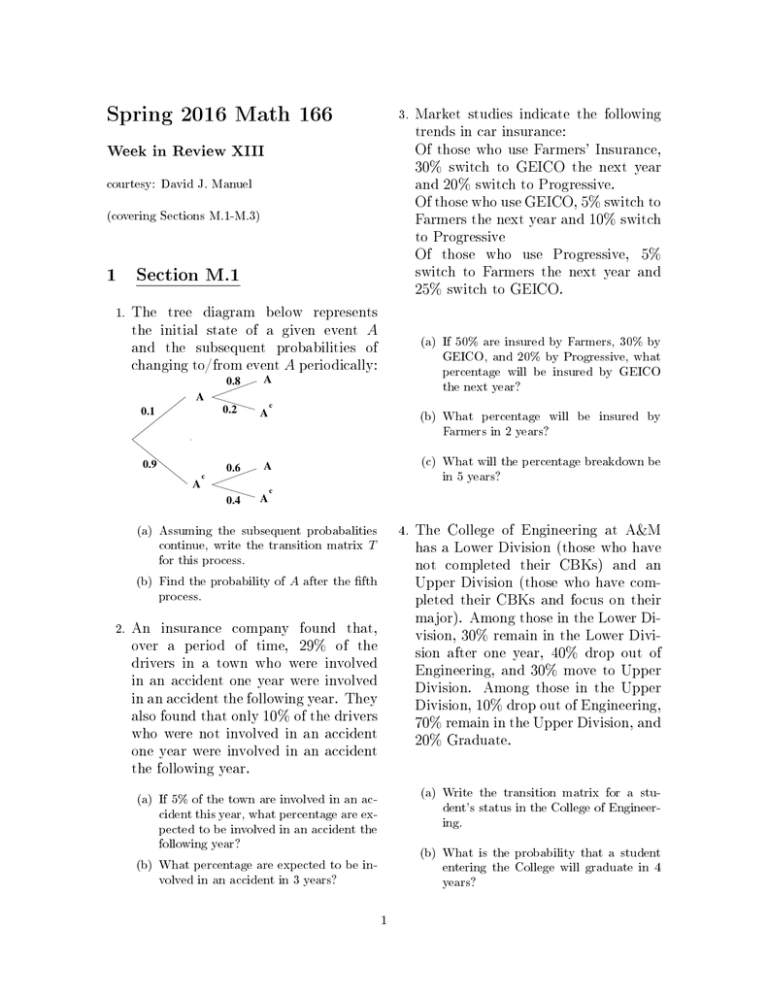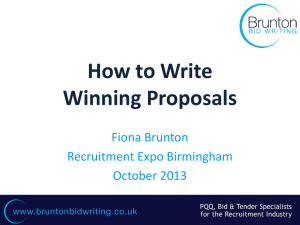Spring 2016 Math 166
advertisement

Spring 2016 Math 166 3. Market studies indicate the following trends in car insurance: Of those who use Farmers' Insurance, 30% switch to GEICO the next year and 20% switch to Progressive. Of those who use GEICO, 5% switch to Farmers the next year and 10% switch to Progressive Of those who use Progressive, 5% switch to Farmers the next year and 25% switch to GEICO. Week in Review XIII courtesy: David J. Manuel (covering Sections M.1-M.3) 1 Section M.1 1. The tree diagram below represents the initial state of a given event A and the subsequent probabilities of changing to/from event A periodically: 0.8 (a) If 50% are insured by Farmers, 30% by GEICO, and 20% by Progressive, what percentage will be insured by GEICO the next year? A A 0.2 0.1 0.9 0.6 c (b) What percentage will be insured by Farmers in 2 years? A (c) What will the percentage breakdown be in 5 years? A c A c 0.4 A 4. The College of Engineering at A&M (a) Assuming the subsequent probabalities continue, write the transition matrix T for this process. has a Lower Division (those who have not completed their CBKs) and an Upper Division (those who have completed their CBKs and focus on their major). Among those in the Lower Division, 30% remain in the Lower Division after one year, 40% drop out of Engineering, and 30% move to Upper Division. Among those in the Upper Division, 10% drop out of Engineering, 70% remain in the Upper Division, and 20% Graduate. (b) Find the probability of A after the fth process. 2. An insurance company found that, over a period of time, 29% of the drivers in a town who were involved in an accident one year were involved in an accident the following year. They also found that only 10% of the drivers who were not involved in an accident one year were involved in an accident the following year. (a) Write the transition matrix for a student's status in the College of Engineering. (a) If 5% of the town are involved in an accident this year, what percentage are expected to be involved in an accident the following year? (b) What is the probability that a student entering the College will graduate in 4 years? (b) What percentage are expected to be involved in an accident in 3 years? 1 2 Find the limiting matrix and interpret each entry in the upper right block. Section M.2-M.3 1. Determine which of the above pro- cesses are regular Markov processes. For those that are, give the steadystate. For those that aren't, nd and interpret the limiting matrix. (a) (b) (c) (d) #1 #2 #3 #4 2. An auto insurance company classies its customers in one of three categories: poor drivers, satisfactory drivers, and preferred drivers. Each year, 30% of poor drivers move to satisfactory, and 15% of satisfactory drivers move to preferred. In addition, 20% of preferred drivers are pushed back to satisfactory, and 10% of satisfactory drivers are pushed back to poor. Customers are never moved between poor and preferred in one year. (a) Assuming all customers start as satisfactory drivers, what percentage of new customers in a given year will be in each category after 3 years? (b) Show that this is a regular Markov process. (c) Find the steady state. 3. A credit union classies auto loans into one of four categories: (F)=paid in full, (G)=good standing, (A)=in arrears (missing payments), or (B)=bad debt (turned over to a collection agency). Past history indicates the following changes: (G): 10% become paid in full, 20% become in arrears (A): 5% become paid in full, 40% become in good standing, 20% become bad debts. 2





